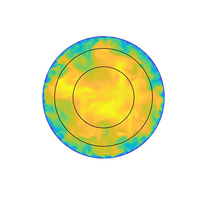Sensitivity study of resolution and convergence requirements for the extended overlap region in wall-bounded turbulence
IF 2.5
3区 物理与天体物理
Q2 PHYSICS, FLUIDS & PLASMAS
引用次数: 0
Abstract
Direct numerical simulations (DNSs) are among the most powerful tools for studying turbulent flows. Even though the achievable Reynolds numbers are lower than those obtained through experimental means, DNS offers a clear advantage: The entire velocity field is known, allowing for the evaluation of any desired quantity. This capability includes the computation of derivatives of all relevant terms. One such derivative provides the indicator function, which is the product of the wall distance and the wall-normal derivative of the mean streamwise velocity. This derivative may depend on mesh spacing and distribution, but it is extremely affected by the convergence of the simulation. The indicator function is crucial for understanding inner and outer interactions in wall-bounded flows and describing the overlap region between them. We find a clear dependence of this indicator function on the mesh distributions we examine, raising questions about classical mesh and convergence requirements for DNS and achievable accuracy. Within the framework of the logarithmic plus linear overlap region, coupled with a parametric study of channel flows and some pipe flows, sensitivities of extracted overlap parameters are examined. This study reveals a path to establishing their high- or nearly asymptotic values at modest Reynolds numbers, but larger than the ones used in this work, accessible by high-quality DNS with reasonable cost.

壁面湍流中扩展重叠区域分辨率和收敛要求的敏感性研究
直接数值模拟(DNS)是研究湍流的最强大工具之一。尽管可实现的雷诺数低于通过实验获得的雷诺数,但 DNS 仍具有明显的优势:整个速度场是已知的,因此可以评估任何所需的量。这种能力包括计算所有相关项的导数。其中一个导数就是指示函数,它是壁面距离与平均流向速度的壁面法向导数的乘积。该导数可能取决于网格间距和分布,但受模拟收敛性的影响极大。指标函数对于理解壁面流的内外相互作用以及描述它们之间的重叠区域至关重要。我们发现该指标函数与我们研究的网格分布有明显的依赖关系,这就提出了有关 DNS 的经典网格和收敛要求以及可实现精度的问题。在对数加线性重叠区域的框架内,结合对通道流和一些管道流的参数研究,对提取的重叠参数的敏感性进行了检验。这项研究揭示了在雷诺数不大但大于本研究中使用的雷诺数的情况下,通过高质量 DNS 以合理的成本建立高雷诺数或近似值的途径。
本文章由计算机程序翻译,如有差异,请以英文原文为准。
求助全文
约1分钟内获得全文
求助全文
来源期刊

Physical Review Fluids
Chemical Engineering-Fluid Flow and Transfer Processes
CiteScore
5.10
自引率
11.10%
发文量
488
期刊介绍:
Physical Review Fluids is APS’s newest online-only journal dedicated to publishing innovative research that will significantly advance the fundamental understanding of fluid dynamics. Physical Review Fluids expands the scope of the APS journals to include additional areas of fluid dynamics research, complements the existing Physical Review collection, and maintains the same quality and reputation that authors and subscribers expect from APS. The journal is published with the endorsement of the APS Division of Fluid Dynamics.
 求助内容:
求助内容: 应助结果提醒方式:
应助结果提醒方式:


